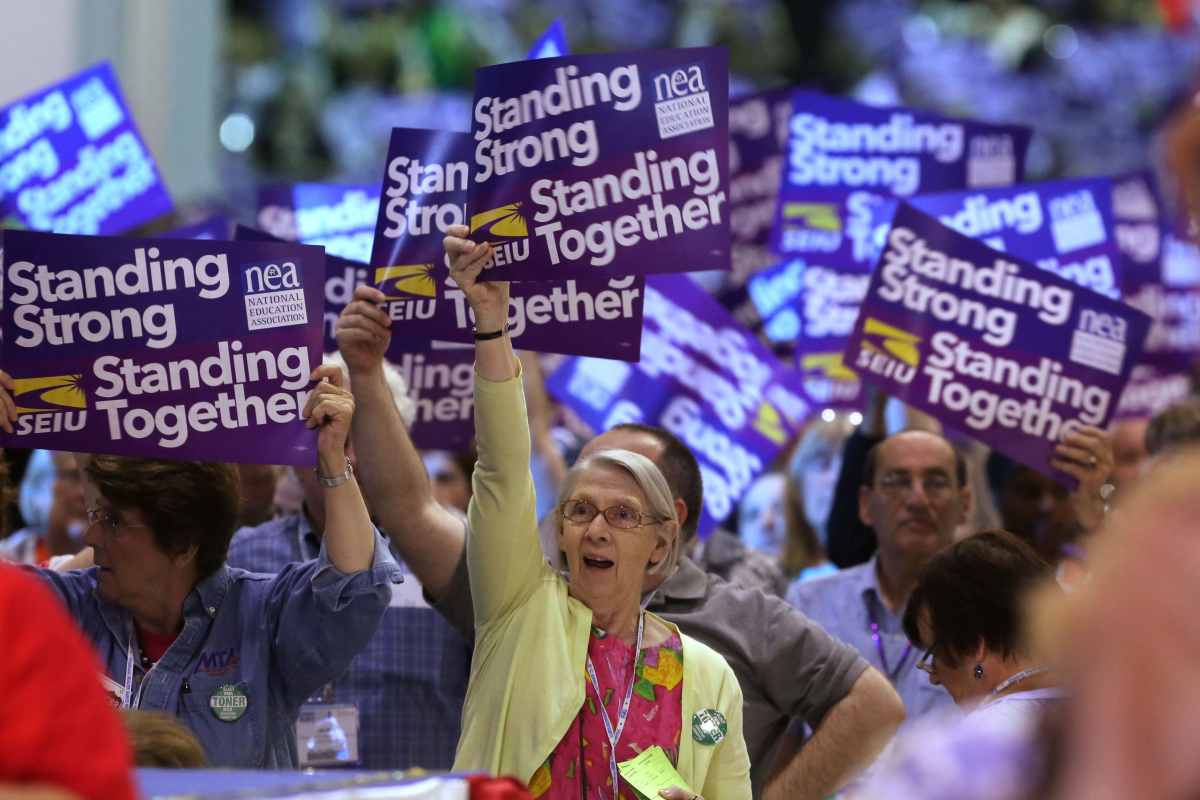Teachers Union Conventions Reflect Common (Core) Frustrations

Astute NEA members noted the union’s growing links to the Service Employees, which has an increasing number of members in the education sector. SEIU President Mary Kay Henry was the keynote speaker on the assembly’s final day. Photo: Rick Runion/NEA.
At national conventions of the two major teacher unions this month, controversy flared over the Common Core, a standardized curriculum largely funded by the privatizers at the Gates Foundation.
Motions at the National Education Association and the American Federation of Teachers proposed to resist the program because of its link to standardized testing.
In the AFT, two militant locals, the Chicago Teachers Union and United Teachers Los Angeles, led the Common Core fight. There were competing motions, with the passage of the weaker one reflecting the position of AFT President Randi Weingarten that Common Core is viable if it’s not connected to standardized testing. While there were not equivalent motions at the NEA Assembly, the debate on Common Core was still very vigorous, especially concerning its funding by the Gates Foundation. (See also A Teacher Decodes Common Core.)
With 3 million members, the NEA is still the nation’s largest union, though its ranks have thinned in recent years because of layoffs and anti-union legislation. It drew 7,100 delegates to mile-high Denver, down from 10,000 a decade ago. The smaller AFT came together the following week in Los Angeles, with half as many delegates.
New NEA officers were selected: Vice President Lily Eskelsen Garcia will replace outgoing President Dennis Van Roekel, reflecting the usual stairway to power. There was only one other candidate on the ballot, and little threat of real competition. No change at the top in AFT, where Weingarten was reelected.
Weingarten also attended the NEA assembly. One reason for her dual attendance is overlapping membership: AFT’s largest local, New York City’s United Federation of Teachers, is in both unions. So are a number of state affiliates, such as Minnesota’s, and locals, including UTLA and United Educators of San Francisco.
Ties to Democrats
Top issues at both conventions included the standardized testing regime, the impact of charter schools, the implementation of No Child Left Behind, and Race to the Top’s funding incentives for restructuring.
Several motions, mainly from California, called for transparency about NEA’s alliances, including teacher training programs connected to the Pearson corporation (a producer of texts, tests, and software) and to the Gates and Broad foundations. Eli Broad is a real estate mogul and major fundraiser for the Democrats. While these motions were either defeated or referred, they reflected a growing distrust of how the leadership attempts to walk on both sides of the “reform” line. Unsavory NEA alliances were also criticized by delegates from the growing “Badass Teachers” caucus of militant teachers.
There was also tension over the unions’ ties to the Democratic Party—especially in the wake of Secretary of Education Arne Duncan’s endorsement of the recent Vergara v. California court decision, which attacks teachers’ due process and job security. There’s a similar case in New York, and copycat legal attacks are pending in 12 other states.

SUPPORT LABOR NOTES
BECOME A MONTHLY DONOR
Give $10 a month or more and get our "Fight the Boss, Build the Union" T-shirt.
NEA delegates passed a motion, authored by leaders of the California Teachers Association, calling for Duncan’s resignation. The AFT likewise criticized Duncan, insisting on an “improvement plan” for him and calling for a “support and improve” approach to teacher evaluation, rather than “test and punish.”
At the NEA gathering, there was also dissent around the early endorsement bestowed on Obama three years ago. No major spokesperson for the Democrats has attended the convention in years.
However, the only motion calling for a national day of action responding to the union-busting Vergara and other aspects of “education deform” was defeated. And neither leadership expressed real intent to end its dependency on the Democrats.
Ties to SEIU
Astute NEA members noted the union’s growing links to the Service Employees (SEIU), which has an increasing number of members in the education sector, primarily classified workers such as teaching assistants, clerical staff, and school bus drivers, a segment of the workforce the NEA is also trying to organize. SEIU President Mary Kay Henry was the keynote speaker on the assembly’s final day.
There are ongoing meetings between top leaders of the two unions, as well as between NEA and AFT and AFSCME. President Van Roekel acknowledged and praised these discussions. Some NEA members fear that the union’s leadership is going to insist on more power so they can make agreements with other unions with little or no feedback, as occurred with the proposed merger of the NEA and AFT in 1998.
These fears were stoked by motions, supported by leadership in 21 states, advocating an end to annual conventions and even calling for a union constitutional convention. The motions were defeated. The end of annual conventions would severely limit the ability of caucuses and other dissident groupings to organize nationally.
As always, there were solidarity motions, mostly submitted by the NEA Peace and Justice Caucus. Both conventions passed endorsements of the postal union-led Staples boycott, and NEA passed motions calling for a halt to deportations of immigrant youth and an end to fracking. Measures on the Keystone XL pipeline and non-intervention in the Middle East were defeated.
The decline in support for such measures over the last decade reflects the heavy influence in the NEA of suburban locals and delegations from “Right to Work” states. More distressing was a defensive mentality in the face of the corporate assault on public education, with little organized response on the national level.
Bill Balderston is a retired teacher and organizer for the Oakland Education Association, and issues chair of the NEA Peace and Justice Caucus.



